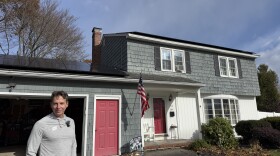About 370,000 people in New Hampshire – more than a quarter of the state’s population – are currently under outdoor water use restrictions due to the ongoing severe drought.
The drought has been escalating since May across the region and is now extreme in some parts of New England, with no substantial rainfall expected soon.
It’s prompted mandatory limits on outdoor water use in more than 150 local systems and towns in New Hampshire. These restrictions are concentrated in Rockingham County but extend throughout the state, in every county except Coos.
The small Upper Valley town of Enfield made its restrictions mandatory about a week ago. Town manager Ryan Aylesworth says they get their higher-quality water from lower-producing wells – heightening the risks from drought-related depletion.
“Irrigating your lawn for green grass, washing your lawn so it’s shiny and nice – these are the sorts of things that, at a time like this, just really need to take a back seat,” Aylesworth says.
He says residents have been good about following the restrictions so far, and that they aren’t banning people from watering food-producing gardens. Town data for earlier in the season, he says, shows people were already cutting back voluntarily due to the drought.
But most of Enfield – and close to half of New Hampshire – uses private wells, which aren’t subject to any regulations. Aylesworth says those residents are still encouraged to follow the public utility’s restrictions and stagger large water withdrawals, since they all share one aquifer.
“We’re obviously are leaving this in Mother Nature’s hands to an extent,” he says. “But every little bit that we can each do as a household to conserve the water that we have will make it less likely that we encounter water scarcity when we need it.”
The shallower the well, the sooner it’s likely to run dry, pulling up sediment and affecting water volume and quality. State officials say deeper wells may show signs of stress later in the season, even if the drought conditions begin to improve.
The problem stems from a low winter snowpack – not enough to recharge groundwater for the growing season – and sporadic rain patterns this summer. Too much rain at once, and the ground can’t absorb it effectively, leading to drought even amid bouts of precipitation.
Scientists say these trends will intensify as the climate warms.
NHPR's Daniela Allee contributed reporting to this story.








